South America has a rich dance tradition - an amalgamation of its indigenous cultures and European influences. There is a Portuguese, Spanish and African aspect to the dances of this beautiful, geographically diverse continent. Each region in almost all the countries of South America can boast of a rich folk and traditional culture, though there is also a striking similarity between some dances.
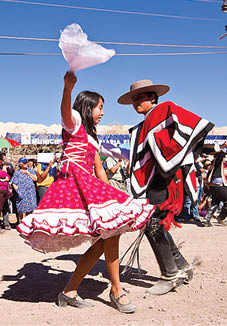
Cueca (Chile) - This National Dance of Chile is distinguished by the black-base costumes that are worn by the male dancers and the flowery dresses of the accompanying women performers. As the men and women face each other, they wave a handkerchief, and the dancing commences when the music begins to play. Facial expressions, artistic movements and emotions are the characteristics of this dance. Performed to the tune of the guitar and the accordion, the Chilean Cueca is different from the Argentinian and Bolivian versions.
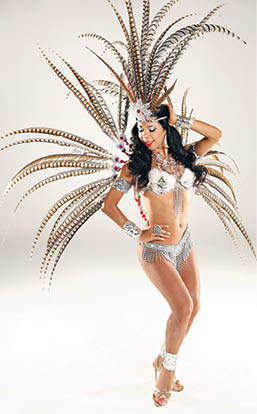
Samba (Brazil) – The Samba is a rhythmic dance of Brazil, with influences of a colonial Portuguese style. It is performed to local Samba music. This is actually not a single, but a thread of dances. Samba dancers’ actions appear to be gentle on the knees and ankles. The effortless movements of the dancers, while turning their heads and extending their arms, are demonstrated by a quick-quick-slow technique. Women dance one after the other, encircling each other, moving their legs, feet and hips, and clap as they exit. The instruments used in Samba are the tamborim, chocalho, reco-reco and cabaca.
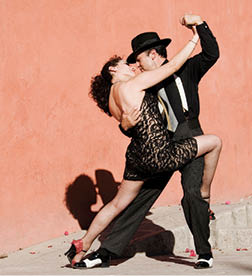
Tango (Argentina) – The Tango is a social dance that originated in the outskirts of Buenos Aires, the capital of Argentina. It is a ‘close’ dance, where the chest of a dancer touches that of the facing partner. The major highlight of this dance is its speed. There is no set pattern of dancing the Tango; immense improvisation is a distinguishing feature of this dance. An important aspect is the display of emotions.
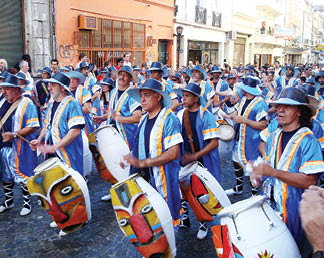
Candombe (Uruguay) - Candombe was brought into Uruguay by African slaves. As the Comparsa (white dancers with blackened faces) join the Candombera (black dancers), the Chico, Repique and Piano drums are sounded aggressively – though the movements are graceful. Juggling, balancing and acrobatic manoeuvers are a few of the characteristics of this traditional Uruguay country dance.

Joropo (Venezuela) - The influence of the European invaders, especially from Spain and Portugal, combined with the African slave culture, is evident in this dance. Joropo means performance. The style resembles the European Waltz. The tone is set by the harp (played by the singer), the strumming of the guitar and the ‘Maracas’. The male and female performers, holding each other tightly, glide on the floor in a sweeping motion. The male dancers, on cue, stomp their feet hard on the ground/stage.
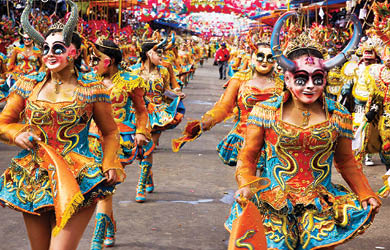
Diablada (Bolivia) - Translated as the ‘Dance of the Devils’, Diablada is a traditional Bolivian dance. When the Spanish settlers crossed the Andes mountains they embraced local dance traditions, and the rituals involving demons in the caves of Bolivia found their way into dance. The dancers replicate the movements of angels and demons, in an enactment featuring the vanquishing of demons by Saint Michael. The costumes worn by the dancers are ornate and heavy. The choreography is difficult and complex.
El Tamborito (Panama) - El Tamborito, or ‘Little Drum’, is the traditional dance form of Panama. It is performed by couples to the beats of a band, mainly during festivals,. The dancers form a circle and use a shuffling technique. As the speed increases the audience shouts ‘Vivas’! Women wear a gown called the La Pollera and the men wear a costume known as El Montuno.
Pasillo (Colombia) - Dating back to the nineteenth century, Pasillo is very popular in Columbia. The elements of this dance are classical in nature. Each village of Colombia has a different way of performing Pasillo. The instruments that are played during a Pasillo performance are the guitar and the mandolin.
Marinera (Peru) - Handkerchiefs are used as props in this beautiful couple dance that is performed to the tune of the clarinet, guitar and bugles. The dance is elegant and slow paced (the Marinera Nortena, a variation of this dance, is quick in pace, and stylish). The Marinera has been accorded National status in Peru. The uniqueness in this dance is that while the man wears shiny shoes, the woman dancer moves barefoot on the floor.
The Dance of the Chapetones (El Salvador) - El Salvador is a quaint, ‘sleepy’ country to the north of South America. However, come The Dance of the Chapetones the folks are wide-awake. The Spanish roots of this dance are evident. The movements are slow and laid back. A woman representing the queen stands in the middle, surrounded by slow dancing men wearing tuxedo coats and shiny boots.
Read More...